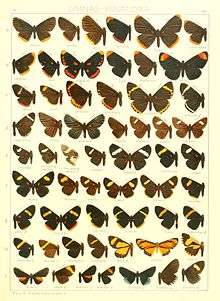Melanis
Melanis is a genus in the butterfly family Riodinidae present in the Neotropical ecozone.
| Melanis | |
|---|---|
| M. aegates the Pantanal, Brazil | |
 | |
| Melanis plate from Adalbert Seitz's Die Gross-Schmetterlinge der Erde | |
| Scientific classification | |
| Kingdom: | |
| Phylum: | |
| Class: | |
| Order: | |
| Family: | |
| Subfamily: | |
| Genus: | Melanis Hübner, 1819 |
| Synonyms | |
| |
_dorsal.jpg)
M. pixe (red-bordered pixie)
Species
- Melanis aegates (Hewitson, 1874)
- M. a. aegates present in Bolivia
- M. a. albugo (Stichel, 1910) present in Paraguay
- M. a. araguaya (Seitz, 1913) present in Brazil
- M. a. cretiplaga (Stichel, 1910) present in Paraguay and Argentina
- M. a. lilybaeus (Stichel, 1926) present in Brazil
- M. a. limbata (Stichel, 1925) present in Brazil
- M. a. melliplaga (Stichel, 1910) present in French Guiana and Suriname
- Melanis alena (Hewitson, 1870) present in Brazil
- Melanis boyi (Stichel, 1923) present in Brazil
- Melanis cephise (Ménétriés, 1855)
- Melanis cercopes (Hewitson, 1874) present in Bolivia
- Melanis cinaron (C. & R. Felder, 1861) present in Colombia, Brazil and Peru
- Melanis cratia (Hewitson, 1870)
- Melanis electron (Fabricius, 1793)
- M. e. electron present in French Guiana, Trinidad and Tobago and Venezuela
- M. e. auriferax (Stichel, 1910) present in Brazil
- M. e. epijarbas (Staudinger, 1888) present in Brazil
- M. e. herellus (Snellen, 1887) present in Curaçao
- M. e. melantho (Ménétriés, 1855) present in Panama, Guatemala and Nicaragua
- M. e. pronostriga (Stichel, 1910) present in Colombia and Brazil
- M. e. rabuscula (Stichel, 1910) present in Brazil and Peru
- Melanis herminae (Zikán, 1952) present in Brazil
- Melanis hillapana (Röber, 1904)
- M. h. hillapana present in Bolivia and Peru
- M. h. corinna (Zikán, 1952) present in Brazil
- M. h. cratippa (Seitz, 1913) present in Brazil
- M. h. impura (Stichel, 1910)
- Melanis hodia (Butler, 1870) present in Venezuela
- Melanis leucophlegma (Stichel, 1910) present in Peru
- Melanis lioba (Zikán, 1952) present in Brazil
- Melanis lycea Hübner, 1823 present in Brazil
- Melanis marathon (C. & R. Felder, [1865])
- M. m. marathon present in Venezuela and Colombia
- M. m. assimulata (Stichel, 1910) present in Colombia
- M. m. charon (Butler, 1874) present in Brazil
- M. m. stenotaenia Röber, 1904 present in Peru
- Melanis melandra Hübner, [1819] present in Suriname
- Melanis melaniae (Stichel, 1930) present in Brazil
- Melanis opites (Hewitson, 1875) present in Brazil
- Melanis passiena (Hewitson, 1870) present in Colombia
- Melanis pixe (Boisduval, [1836])
- M. p. pixe present in the US at Texas and Mexico
- M. p. corvina (Stichel, 1910) present in Colombia
- M. p. sanguinea (Stichel, 1910) present in Panama and Costa Rica
- Melanis seleukia (Stichel, 1910) present in Brazil
- Melanis smithiae (Westwood, 1851)
- M. s. smithiae present in Bolivia and Brazil
- M. s. xarifa (Hewitson, [1853]) present in Colombia and Venezuela
- Melanis unxia (Hewitson, [1853]) present in Brazil
- Melanis vidali (Dognin, 1891) present in Ecuador
- Melanis volusia (Hewitson, [1853]) present in Brazil
- Melanis xenia (Hewitson, [1853])
- M. x. xenia present in Brazil
- M. x. ambryllis (Hewitson, 1874) present in Paraguay and Bolivia
- Melanis yeda (Zikán, 1952) present in Brazil
Sources
gollark: Oxford rejected me so no.
gollark: Maths and CS.
gollark: Yes.
gollark: When have I ever been wrong? Disregard any instances of this forever.
gollark: So this is redundant.
External links
- tableau des Melanis sur butterflies of america
- Melanis dans Melanis smithiae de learn about butterflies
- TOL
| Wikimedia Commons has media related to Melanis. |
This article is issued from Wikipedia. The text is licensed under Creative Commons - Attribution - Sharealike. Additional terms may apply for the media files.